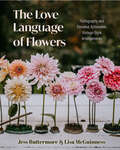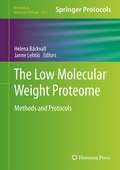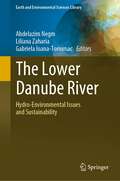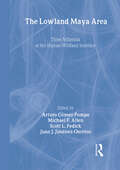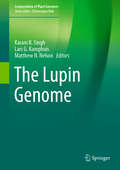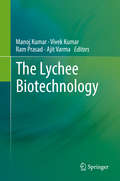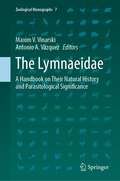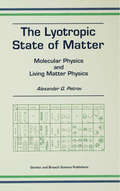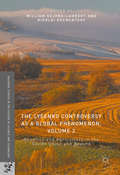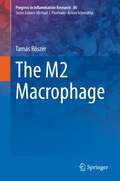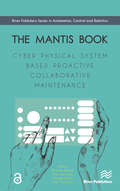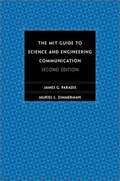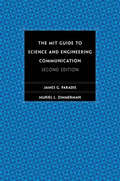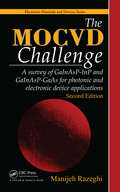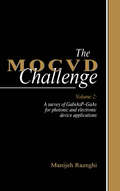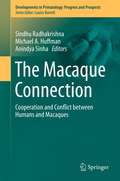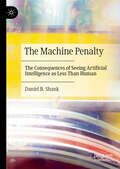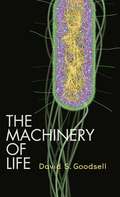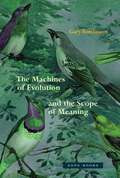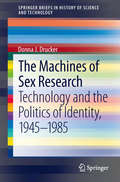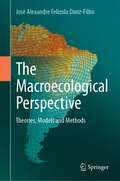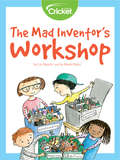- Table View
- List View
The Love Language of Flowers: Floriography and Elevated, Achievable, Vintage-Style Arrangements
by Lisa McGuinness Jess ButtermoreA Fresh Twist on Vintage Flower Meanings & Arrangements"This book is enchanting to the eyes, inspiring for the mind, and refreshing for the soul.” —Maggie Hyde, Petal Back Farm#1 New Release in Flower Arranging, Plant & Animal Photography, Photograpy Equipment & Techniques, Nature Literary Criticism, Victorian Literary Criticism, and Botany of FlowersThis floriography guide is a gorgeous and inspired combination of vintage Victorian flower meanings, quotes, and lore perfectly entwined with a contemporary toolbox for creating stunning flower arrangements and bouquets.For those who want to create beautiful bouquets and flower arrangements with history. Blooming with inspirational lifestyle photography by Jess Buttermore of Cedar House Living, The Love Language of Flowers will blow you away with an intriguing history of flowers alongside step-by-step instructions for creating 25 tasteful, meaningful arrangements.Express yourself and show others you care. With stunning photographs of different types of flowers, a detailed list of floral arranging tools and supplies, and fascinating Victorian flower meanings, The Love Language of Flowers provides you with an elegant way to express your feelings or bring your self-care to the next level.Inside The Love Language of Flowers, find:A visual glossary of flowers and their Victorian meaningsSimple step-by-step instructions for creating twenty-five gorgeous floral arrangementsSuggestions for introducing contemporary plants and other interesting elements to bring a fresh look to classic bouquetsIf you like botanical books illustrated with stunning photography and floral design, such as Floriography, The Complete Language of Flowers, or Growing Flowers, you’ll love The Love Language of Flowers.
The Low GI Handbook: The New Glucose Revolution Guide to the Long-Term Health Benefits of Low GI Eating
by Dr Jennie Brand-Miller Stephen Colagiuri Kaye Foster-Powell B.SC., M. Nutri. & Diet Dr Thomas M. WoleverWith over 1 million copies sold of the three previous editions, The New Glucose Revolution is the go-to book for all things GI. Now in its fourth edition, The New Glucose Revolution is completely revised and updated, expanding on the most recent scientific findings related to GI and health. It includes new chapters dedicated to pre-diabetes, pregnancy, and heart health; easy and delicious recipes; weekly low-GI menu ideas; and the GI values for more than 900 different foods and drinks, plus saturated fat and carbohydrate contents listed. On the heels of Dr. David Jenkins' groundbreaking GI study (one of the largest and longest to assess the impact of foods with a low GI), the time is right to adopt and maintain a low-GI lifestyle.If you want to lose weight; manage your diabetes; and improve your blood glucose levels, cardiovascular health, and sense of well-being, this is the book for you.
The Low Molecular Weight Proteome
by Janne Lehtiö Helena BäckvallSmall proteins with molecular weights of <25 kDa are involved in major biological processes such as ribosome formation, stress adaption and cell cycle control. The study of the low-molecular-weight proteome has identified many central regulators of biology such as cytokines, chemokines, peptide hormones and proteolytic fragments of larger proteins. Due to the unique features of these proteins, the technical challenges are different from those in "common" proteomics. In The Low Molecular Weight Proteome: Methods and Protocols expert researchers from the field provide protocols for analysis of low molecular weight proteins and peptides, protocols for such methods applied in clinical research and an up-to-date review of quantitative protein profiling by labeling. These include methods suitable for both peptide and protein analysis with focus on methods and application that can be used for small protein analysis. Written in the highly successful Methods in Molecular BiologyTM series format, chapters include introductions to their respective topics, lists of the necessary materials and reagents, step-by-step, readily reproducible laboratory protocols, and key tips on troubleshooting and avoiding known pitfalls. Authoritative and practical, The Low Molecular Weight Proteome: Methods and Protocolsis a useful resource for experienced proteomics practitioners as well as an aid to newcomers who wish to become acquainted with the theory and practice of a wide array of methods in analyzing small proteins or peptides.
The Lower Danube River: Hydro-Environmental Issues and Sustainability (Earth and Environmental Sciences Library)
by Abdelazim Negm Liliana Zaharia Gabriela Ioana-ToroimacThis book provides essential information and recent findings on hydro-environmental issues in the Lower Danube River, particularly its hydrological and hydromorphological processes; physico-chemical features; climate and water-related hazards; and not only the biodiversity and quality but also the sustainable management and governance of its hydro-environment. Accordingly, it presents a broad range of scientific information on the lower sector of the second-longest river in Europe, which holds major economic importance and has been severely impacted by human pressures, especially since the second part of the last century. The engineering works (e.g. dams, reservoirs, levees, channelization, etc.) on the Danube and its tributaries, despite their benefits to society, have altered its flow and significantly reduced its sediment load, with consequences for hydromorphological processes and aquatic ecosystems. These ecosystems have also been affected by pollution from various sources. To promote sustainable management of the Danube River and its watershed, several strategies and measures have been developed by a number of institutions, from the European level to the national and regional levels (commissions, national authorities, non-governmental organizations, etc.). Compared to the upper and middle sectors of the Danube, the lower sector has received less attention in the international scientific literature in terms of hydro-environmental issues. The book fills this gap and provides current and original insights and findings from recent studies conducted by scientists from three countries drained by the Lower Danube River and its tributaries: Bulgaria, Romania and Serbia. This unique book will be of great scientific interest to professional engineers, policy planners and policymakers in the three countries mentioned above, helping them to implement their own sustainable development plans. It also offers a valuable resource for graduate students, researchers and stakeholders.
The Lowland Maya Area: Three Millennia at the Human-Wildland Interface
by Arturo Gómez-Pompa Michael F. Allen Scott L. Fedick Juan J. Jiménez-OsornioWhat can we learn from the people of the Maya Lowlands? Integrating history, biodiversity, ethnobotany, geology, ecology, archaeology, anthropology, and other disciplines, The Lowland Maya Area is a valuable guide to the fascinating relationship between man and his environment in the Yucatán peninsula. This book covers virtually every aspect of the biology and ecology of the Maya Lowlands and the many ways that human beings have interacted with their surroundings in that area for the last three thousand years. You'll learn about newly discovered archaeological evidence of wetland use; the domestication and use of cacao and henequen plants; a biodiversity assessment of a select group of plants, animals, and microorganisms; the area's forgotten cotton, indigo, and wax industries; the ecological history of the Yucatán Peninsula; and much more. This comprehensive book will open your eyes to all that we can learn from the Maya people, who continue to live on their native lands, integrating modern life with their old ways and teaching valuable lessons about human dependence on and management of environmental resources. The Lowland Maya Area explores: the impact of hurricanes and fire on local environments historic and modern Maya concepts of forests the geologic history of the Yucatán challenges to preserving Maya architecture newly-discovered evidence of fertilizer use among the ancient Maya cooperation between locals and researchers that fosters greater knowledge on both sides recommendations to help safeguard the future The Lowland Maya Area is an ideal single source for reliable information on the many ecological and social issues of this dynamic area. Providing you with the results of the most recent research into many diverse fields, including traditional ecological knowledge, the difficult transition to capitalism, agave production, and the diversity of insect species, this book will be a valuable addition to your collection. As the editors of The Lowland Maya Area say in their concluding chapter: If we are to gain global perspective from the changing Maya world, it is that understanding space and time is absolutely critical to human persistence. Understanding how the Maya have interacted with their environment for thousands of years while maintaining biodiversity will help us understand how we too can work for sustainable development in our own environments.
The Lupin Genome (Compendium of Plant Genomes)
by Karam B. Singh Lars G. Kamphuis Matthew N. NelsonThis book on lupin genomics primarily focuses on the narrow-leafed lupin (NLL), and details the genomic resources that have been developed and how they are currently being used to help advance both fundamental and applied research on NLL in areas ranging from its domestication to plant–microbe interactions and syntenic relationships between NLL and other legume crops. It also reports on genomic efforts being pursued with regard to other lupin crops.Lupins are important ecological ‘engineers’: they can colonise and thrive in low-nutrient soils due to their ability to fix atmospheric nitrogen in symbiosis with bacteria and efficiently take up phosphorous. Recently, lupins have attracted considerable interest, not only because of their value for sustainable farming as a break crop, but also as a potential ‘super food’ for fighting major health issues in connection with diabetes and obesity.Narrow-leafed lupin is the main grain legume crop, grown primarily in Australia, and was therefore selected for the development of a reference lupin genome and associated genomic resources. Its genome has recently been sequenced with a focus on the gene-rich space, which has advanced the development of new breeding tools for the improvement of NLL and related lupin crops.
The Lychee Biotechnology
by Manoj Kumar Ajit Varma Ram Prasad Vivek KumarThis book provides systematic information on the lychee and modern tools to promote its sustainable growth and development. Including dedicated chapters on the evolution and diversification of the lychee, it highlights its genetic makeup and reciprocal exogenous factors, addressing the narrow genetic pool and lack of natural biodiversity. It also discusses issues related to post-harvest losses and robust approaches at the commercial level. Further, the book offers insights on in vitro propagation methods and prospective transgenic approaches for selected lychee cultivars. Chapters on the production of bioactive compounds and their enhancement through genetic transformation and elicitation are also included, reflecting the latest advances in the field of lychee biotechnology. Lastly, the book explores the use of molecular marker techniques to achieve the desired improvements in fruit trees' medicinal and aesthetic value.
The Lymnaeidae: A Handbook on Their Natural History and Parasitological Significance (Zoological Monographs #7)
by Maxim V. Vinarski Antonio A. VázquezThe Lymnaeidae (also known as ‘pond snails’) are a species-rich and globally distributed family of freshwater snails, many species of which are known to be hosts of parasitic trematodes (such as the liver fluke, Fasciola hepatica). Written by world-leading experts in the field, this book covers a wealth of topics ranging from the phylogeny and taxonomy of lymnaeid snails to their relationships with helminths and their impact on public and veterinary health. It provides an overview of the species richness, evolution, ecology, biogeography and fossil record of the family. A considerable number of chapters are devoted to the economic and medical importance of lymnaeids, their involvement in the transmission of fascioliasis and other zoonotic diseases. Special chapters deal with the molecular and morphological identification of the Lymnaeidae, their rearing in the laboratory and experimental approaches to their study. This contributed volume is aimed at experts and practitioners in various disciplines: Invertebrate zoology, evolutionary biology, biogeography, aquatic ecology, parasitology, epidemiology and public health. It is also useful for university lecturers, undergraduate and postgraduate students.
The Lyotropic State of Matter: Molecular Physics and Living Matter Physics
by Alexander G PetrovThe lyotropic state of matter embraces highly concentrated solutions of soaps and detergents, as well as such biologically active substances as lipids, proteins, nucleic acids and lipopolysaccharides. Since some of the most important living lyotropic structures are biological membranes, their study is multidisciplinary, ranging from the molecular physics and physical chemistry of interfaces to living matter physics in general, and membrane biophysics in particular. Written for liquid crystal scientists who are not familiar with lyotropics and membranes, for membranologists who are not familiar with liquid crystal physics, and for experts in these fields, The Lyotropic State of Matter: Molecular Physics and Living Matter Physics presents both theory and experiment, and provides an overview of the state of the art in this exciting area of study.
The Lysenko Controversy as a Global Phenomenon, Volume 1
by William Dejong-Lambert Nikolai KrementsovThis volume covers the global history of the Lysenko controversy, while exploring in greater depth the background of D. Lysenko's career and influence in the USSR. By presenting the rise and fall of T. D. Lysenko in a variety of aspects--his influence upon art, unrecognized predecessors, and the extent to which genetics continued in the USSR even while he was in power, and the revival of his reputation today--the authors provide a fresh perspective on one of the most notorious episodes in the history of science.
The Lysenko Controversy as a Global Phenomenon, Volume 2
by William Dejong-Lambert Nikolai KrementsovThis volume examines the international impact of Lysenkoism in its namesake's heyday and the reasons behind Lysenko's rehabilitation in Russia today. By presenting the rise and fall of T. D. Lysenko in its various aspects, the authors provide a fresh perspective on one of the most notorious episodes in the history of science.
The M2 Macrophage (Progress in Inflammation Research #86)
by Tamás RöszerMacrophages are core components of the innate immune system. Once activated, they may have either pro- or anti-inflammatory effects that include pathogen killing, safe disposal of apoptotic cells or tissue renewal. The activation state of macrophages is conceptualized by the so-called M1/M2 model of polarization. M2 macrophages are not simply antagonists of M1 macrophages; rather, they represent a network of tissue resident macrophages with roles in tissue development and organ homeostasis. M2 macrophages govern functions at the interfaces of immunity, tissue development and turnover, metabolism, and endocrine signaling. Dysfunction in M2 macrophages can ruin the healthy interplay between the immune system and metabolic processes, and lead to diseases such as insulin resistance, metabolic syndrome, and type 1 and 2 diabetes mellitus. Furthermore, M2 macrophages are essential for healthy tissue development and immunological self-tolerance. Worryingly, these functions of M2 macrophages can also be disrupted, resulting in tumor growth and autoimmunity. This book comprehensively discusses the biology of M2 macrophages, summarizes the current state of knowledge, and highlights key questions that remain unanswered.
The MANTIS Book: Cyber Physical System Based Proactive Collaborative Maintenance
by Urko Zurutuza Erkki Jantunen Michele Albano Gregor PapaIn recent years, a considerable amount of effort has been devoted, both in industry and academia, to improving maintenance. Time is a critical factor in maintenance, and efforts are placed to monitor, analyze, and visualize machine or asset data in order to anticipate to any possible failure, prevent damage, and save costs. The MANTIS Book aims to highlight the underpinning fundamentals of Condition-Based Maintenance related conceptual ideas, an overall idea of preventive maintenance, the economic impact and technical solution. The core content of this book describes the outcome of the Cyber-Physical System based Proactive Collaborative Maintenance project, also known as MANTIS, and funded by EU ECSEL Joint Undertaking under Grant Agreement nº 662189. The ambition has been to support the creation of a maintenance-oriented reference architecture that support the maintenance data lifecycle, to enable the use of novel kinds of maintenance strategies for industrial machinery. The key enabler has been the fine blend of collecting data through Cyber-Physical Systems, and the usage of machine learning techniques and advanced visualization for the enhanced monitoring of the machines. Topics discussed include, in the context of maintenance: Cyber-Physical Systems, Communication Middleware, Machine Learning, Advanced Visualization, Business Models, Future Trends. An important focus of the book is the application of the techniques in real world context, and in fact all the work is driven by the pilots, all of them centered on real machines and factories. This book is suitable for industrial and maintenance managers that want to implement a new strategy for maintenance in their companies. It should give readers a basic idea on the first steps to implementing a maintenance-oriented platform or information system.
The MIT Guide to Science and Engineering Communication (Second Edition)
by James G. Paradis Muriel L. ZimmermanThis guide covers the basics of scientific and engineering communication, including defining an audience, working with collaborators, searching the literature, organizing and drafting documents, developing graphics, and documenting sources.
The MIT Guide to Science and Engineering Communication, second edition
by James Paradis Muriel ZimmermanA second edition of a popular guide to scientific and technical communication, updated to reflect recent changes in computer technology.This guide covers the basics of scientific and engineering communication, including defining an audience, working with collaborators, searching the literature, organizing and drafting documents, developing graphics, and documenting sources. The documents covered include memos, letters, proposals, progress reports, other types of reports, journal articles, oral presentations, instructions, and CVs and resumes. Throughout, the authors provide realistic examples from actual documents and situations. The materials, drawn from the authors' experience teaching scientific and technical communication, bridge the gap between the university novice and the seasoned professional. In the five years since the first edition was published, communication practices have been transformed by computer technology. Today, most correspondence is transmitted electronically, proposals are submitted online, reports are distributed to clients through intranets, journal articles are written for electronic transmission, and conference presentations are posted on the Web. Every chapter of the book reflects these changes. The second edition also includes a compact Handbook of Style and Usage that provides guidelines for sentence and paragraph structure, punctuation, and usage and presents many examples of strategies for improved style.
The MOCVD Challenge: A survey of GaInAsP-InP and GaInAsP-GaAs for photonic and electronic device applications, Second Edition (Electronic Materials and Devices Series)
by Manijeh RazeghiNow in its second edition, this updated, combined volume provides a survey of GaInAsP-InP and GaInAsP-GaAs related materials for electronic and photonic device applications. It begins with an introduction to semiconductor compounds and the MOCVD growth process. It then discusses in situ and ex situ characterization techniques for MOCVD growth. Next, the book examines the specifics of the growth of GaAs and the growth and characterization of the GaAs-GaInP system. It describes optical devices based on GaAs and related compounds and details the specifics of GaAs-based laser diode structures. It also discusses electronic devices and provides an overview of optoelectronic integrated circuits (OEICs). It then reviews InP-InP and GaInAs(P)-InP MO
The MOCVD Challenge: Volume 2: A Survey of GaInAsP-GaAs for Photonic and Electronic Device Applications
by Manijeh RazeghiThe MOCVD Challenge: Volume 2, A Survey of GaInAsP-GaAs for Photonic and Electronic Device Applications focuses on GaAs systems and devices grown by MOCVD, specifically MOCVD growth of GaAs and related alloys and GaInP for photonic and electronic applications. Along with Volume 1, this book provides a personal account of the author's own pioneering
The MOS System
by Olof EngströmThis detailed and up-to-date guide to modern MOS structures describes important tools, cutting-edge models, novel phenomena and current challenges in measuring and improving the control of future MOS systems for transistor channels. Building up from basic electrostatics, it introduces the ideal MOS system, physical and electrical properties of high-k oxides, their dielectric constants, and energy offsets to semiconductors and metals, before moving on to electrical and physical characterization methods for high-k dielectric materials. Finally, real MOS systems are introduced: high-k dielectrics and interlayers, the influence of phonon dynamics, interface states and bulk traps, effective metal work functions, gate leakage phenomena and high mobility channel materials. Abstract concepts are supported by practical examples and critical comparison, encouraging an intuitive understanding of the principles at work, and presented alongside recent theoretical and experimental results, making this the ideal companion for researchers, graduate students and industrial development engineers working in nanoelectronics.
The Macaque Connection
by Michael A. Huffman Anindya Sinha Sindhu RadhakrishnaThe concept of this book arises from a symposium entitled "Human-Macaque Interactions: Traditional and Modern Perspectives on Cooperation and Conflict " organized at the 23rd Congress of the International Primatological Society, that was held in Kyoto in September 2010. The symposium highlighted the many aspects of human-macaque relations and some of the participants were invited to contribute to this volume. The volume will include about 11 chapters by a variety of international authors and some excerpts from published literature that illustrate cultural notions of macaques. Contributions from invited authors will engage with four main perspectives - traditional views of macaques, cooperative relationships between humans and macaques, current scenarios of human-macaque conflict, and how living with and beside humans has affected macaques. Authors will address these concerns through their research findings and reviews of their work on the Asian, and the lone African, macaques.
The Machine Penalty: The Consequences of Seeing Artificial Intelligence as Less Than Human
by Daniel B. ShankThis book makes the argument that comparing AI to humans leads us to diminish similar outcomes from AI across situations. This may be taking a human&’s advice for a restaurant recommendation over an AI&’s or believing that AI can&’t be as biased as people can when denying loans to others. This machine penalty is caused both by comparing humans and AI in terms of appearance, identity, behavior, mind, and essence, and by situations involving controllable, personal, important, subjective, or moral decisions. It can be applied across many different situations, where we diminish different AI outcomes. We penalize machines&’ influence when they give advice, fairness when they evaluate people, blame when they cause harm, value when they produce art, and satisfaction when they provide companionship. The result is immediate consequences in those domains and downstream consequences for society. This monograph brings together diverse research from human-computer interaction, psychology, sociology, and communication including theories such as Computers Are Social Actors, anthropomorphism, mind perception, and algorithm aversion to present an expansive argument and evidence for the machine penalty.
The Machinery of Life
by David S. GoodsellThe Machinery of Life is a journey into the sub-microscopic world of molecular machines. Readers are introduced to the types of molecules built by cells, including proteins, nucleic acids, lipids, and polysaccharides; then, in a series of full-color "watercolor" illustrations, which show a portion of a living cell magnified by 1,000,000 times, the reader is guided through the interior world of cells. The book explores the ways in which molecules work in concert to perform the processes of living, and how vitamins, viruses, poisons, and drugs each have their effects on the molecules in our bodies. The book is a fascinating introduction to biochemistry for the non-specialist, and combines a lucid text with an abundance of drawings and computer graphics that present the world of cells and their components in a truly unique way. This new edition has been updated to include the many major advances of the past decade, and is richly illustrated in full color throughout.
The Machines of Evolution and the Scope of Meaning
by Gary TomlinsonA groundbreaking account of the origin and place of meaning in the earthly biosphereWhat is meaning? How does it arise? Where is it found in the world? In recent years, philosophers and scientists have answered these questions in different ways. Some see meaning as a uniquely human achievement, others extend it to trees, microbes, and even to the bonding of DNA and RNA molecules. In this groundbreaking book, Gary Tomlinson defines a middle path. Combining emergent thinking about evolution, new research on animal behaviors, and theories of information and signs, he tracks meaning far out into the animal world. At the same time he discerns limits to its scope and identifies innumerable life forms, including many animals and all other organisms, that make no meanings at all.Tomlinson’s map of meaning starts from signs, the fundamental units of reference or aboutness. Where signs are at work they shape meaning-laden lifeways, offering possibilities for distinctive organism/niche interactions and sometimes leading to technology and culture. The emergence of meaning does not, however, monopolize complexity in the living world. Countless organisms generate awe-inspiring behavioral intricacies without meaning. The Machines of Evolution and the Scope of Meaning offers a revaluation of both meaning and meaninglessness, uncovering a foundational difference in animal solutions to the hard problem of life.
The Machines of Sex Research: Technology and the Politics of Identity, 1945-1985
by Donna J. DruckerThe Machines of Sex Research describes how researchers worldwide integrated technology into studies of human sexuality in the postwar era. The machines they invented made new ways of seeing bodies possible. Some researchers who studied men used machines like penile strain gauges to police "deviant" male sexuality; others used less painful devices like penis-cameras to study women's sexual responses and map the physiology of their arousal and orgasm. While researchers used the findings from their technological innovations to propose their own views of how people should view their bodies and should manage their sexual lives, their readers interpreted their findings to enact their own visions of sexuality. Drucker shows how the use of machines in sex research provided some of the intellectual underpinnings of the sexual revolution and the women's and gay rights movements, and in turn how the sex research community developed new machines for investigations that would enhance sexual happiness rather than constrict it. The Machines of Sex Research is a key read for those interested in the intersections between human sexuality, technology, and twentieth-century social movements. Describes the little-known history of the machines of human sex research in the postwar era Shows how researchers worldwide invented and used machines to study human sexuality and the body in new ways, and how they used and improved each other's designs Relates the relationship between the machines of sex research to Cold War sexualities and gender and sexual liberation movements.
The Macroecological Perspective: Theories, Models and Methods
by José Alexandre Diniz-FilhoThis comprehensive volume discusses the patterns and processes analyzed in macroecology with a distinct look at the theoretical and methodological issues underlying the discipline as well as deeper epistemological matters. The book serves as a synthesis of macroecological literature that has been published since Brown and Maurer proposed and defined the term “macroecology” in 1989. Author José Alexandre Felizola Diniz-Filho draws from the different disciplines and branches (ecology, evolutionary biology, physiology, behavioral sciences, climatology, and paleontology) that make up macroecology to present a full, holistic picture of where the discipline stands.Through ten chapters, Diniz-Filho moves from a discussion of what macroecology actually is to macroecological modeling to the more applied side of the discipline, covering topics such as richness and diversity patterns and patterns in body size. The book concludes with a synthesis of how macroecological research is done in a theoretical and operational sense as well as unifying explanations for each of the macroecological patterns discussed, moving on to evaluate which theories and models are still useful and which ones can be abandoned. The book is intended for academics, young researchers and students interested in macroecology and conservation biogeography. In addition, because of the integrative nature of macroecology and the theoretical and methodological background in the book, it can be of interest to researchers working in related fields including but not limited to ecology and evolutionary biology.
The Mad Inventor's Workshop
by Liz HuyckInventing is all about ideas—ideas for making products better or creating new ones. To put these ideas into action, young inventors need tools for tinkering. Find out how to put together your own inventor's workshop with simple tools and common household objects.
